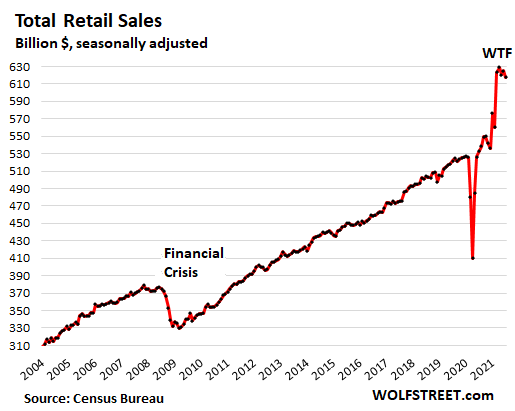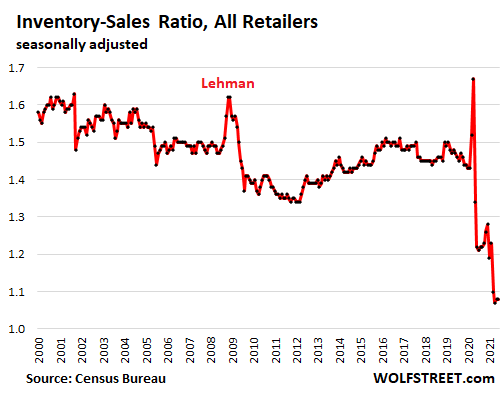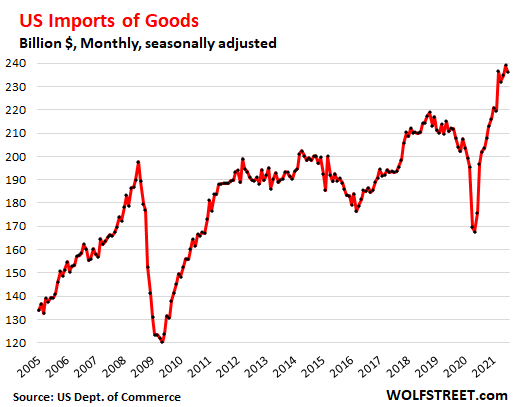
This article was written by Wolf Richter and originally published at Wolf Street
Today’s release of the Fed’s “Beige Book“ – an informal narrative of the economy as told by small and large companies in the 12 Federal Reserve districts – listed “shortage” 77 times, up from 19 times in January.
Shortages of nearly everything, with labor-related shortages being the most prominent. These shortages “restrained” growth, and companies were “unable to meet demand” because of these shortages. Here are some standouts:
- “Extensive,” “widespread,” “intense,” “acute,” “persistent,” “broad,” and “ongoing” “labor shortages.”
- “Worker shortages”
- “Workforce shortages”
- “Shortages of drivers”
- “Truck driver shortage”
- “Chassis” shortage
- “Ongoing microchip shortage”
- “Pervasive resource shortages”
- “Material shortages”
- “Inventory shortages” from retailers to housing.
- “Supply chain shortages”
- “Supply shortages”
- “Shortages of parts”
- “Shortages of inputs and labor”
- “Increasingly severe shortage of auto inventories”
- “Shortages of parts for farm equipment”
- “Restaurants reported severe supply and staffing shortages”
- “Nursing shortages”
- “Raw material shortages”
- “Shortages of labor and other raw materials” that delayed construction
- “Persistent materials shortages”
- “Shortages and higher costs for both labor and non-labor inputs”
- “Retailers noted shortages of and increased lead times for merchandise, particularly on foreign-made goods”
The labor shortages came with “turnover,” and employees leaving their jobs to work somewhere else, which confirms the data in the report on job openings and quits in the most distorted labor market ever.
Some standouts on labor turnover:
- “The number of workers leaving their jobs for other employment was elevated”
- “Employee turnover was noted to have increased”
- “To combat low availability of labor and high turnover rates, many employers significantly increased wages”
- “Businesses also struggled to keep up with the high pace of employee turnover and retirements”
- “Revenue growth was being suppressed by supply side factors, such as low inventories and labor shortages and turnover.
Lead times – a symptom of snarled supply chains, labor shortages, and parts and material shortages – was mentioned 7 times, up from 3 times in January:
- “Manufacturers and services firms experienced delays and long lead times for goods”
- “Longer lead times” for retailers
- “Lead times continued to lengthen, and many manufacturers of perishables turned away business”
- “Retailers noted shortages of and increased lead times for merchandise, particularly on foreign-made goods”
- “Lead times for capital equipment were much longer than usual”
- “Many existing [nonresidential construction] projects remained hampered by long lead times for materials”
- “Persistent materials shortages and extended lead times”
In this environment of shortages of all kinds, amid high demand, price increases were written all over the report, including these 66 mentions:
- “Higher prices” and “high prices”: 15x
- “Price increases”: 12x
- “Increased prices”: 7x
- “Rising prices”: 4x
- “Prices continued to rise”: 4x
- “Price pressures”: 7x
- “Price growth”: 7x
- “Raise prices”: 1x
- “Pushing up prices”: 1x
- “Higher input prices”: 2x
- “Increases in input prices”: 2x
- “Rising input prices”: 2x
- “Input price hikes”: 1x
- “Orders were being canceled and repriced because costs were changing so quickly”: 1x
These shortages and tangled up supply chains are a symptom of the most monstrously overstimulated economy and markets ever, the result of $4 trillion that the Fed has printed since March 2020, and the $5 trillion in deficit spending that the government has blasted out into the economy. $9 trillion in total, in an economy with a GDP of $22.7 trillion (nominal annual rate).
I have documented these effects for over a year now with countless charts that sported hair-raising spikes at the right edge (such as retail sales)…

And with equally hair-raising plunges at the right edge (such as inventories):

One part of the logical solution should have been for the Fed to back off its monetary stimulus a long time ago. Just how ridiculously far the Fed is behind the curve is demonstrated in the Fed’s own Beige Book. The other part of the solution should have been for the government to back off its stimulus a long time ago.
Now comes Morten Engelstoft, CEO of Maersk-owned APM Terminals, one of the world’s largest port and container terminal operators. He sees the chaos in the shipping industry, the port congestion, the exploding transportation costs, the delays, amid a massive surge of imports into the US as many goods that Americans buy are imported, and imports have spiked:

This soaring demand was fueled by the $9 trillion in stimulus in the US. In an interview with the Financial Times, he proposed a solution everyone already knows. For the economy to get out of this “vicious circle,” as he said, consumers should buy less.
He said a “vicious circle” of shortages had formed by this surging demand that strained container carriers, suppliers, ports, and logistics companies.
“We need to work out how we break this vicious circle,” he said. “We need lower [consumer demand] growth to give the supply chain time to catch up, or differently spread out growth. Over a long period of time, we will need to recover efficiency.”
A percentage increase in US imports and exports results in a far larger bump in volumes than elsewhere, because “it’s a percentage of an enormous volume,” he said. “The sheer size of business going through is so enormous that the amount of port capacity, truckers, warehouses, and even labor to man all the equipment has created a bottleneck.”
Consumers would buy less, including fewer imported goods, if the Fed and the government ended the vast amounts of stimulus that are still ongoing in the already most monstrously overstimulated economy ever. It would allow the supply chains to catch up, become efficient again, and it would take some pressure off prices.
After 10 long years of ultra-loose monetary policy from the Federal Reserve, it’s no secret that inflation is primed to soar. If your IRA or 401(k) is exposed to this threat, it’s critical to act now! That’s why thousands of Americans are moving their retirement into a Gold IRA. Learn how you can too with a free info kit on gold from Birch Gold Group. It reveals the little-known IRS Tax Law to move your IRA or 401(k) into gold. Click here to get your free Info Kit on Gold.




The biggest shortage I see is the shortage of decency & common sense in Washington DC.
Certainly a shortage of those things!
It seems to me that the very real economic driver of supply and demand and In our present situation the “labor and supply shortages” are being used strategically to cover for the astronomical monetary debasement. It’s convenient as an explanation to the simpleton’s why prices are rising and they can no longer afford to live. It’s not inflation due to flawed monetary policy & social politics , it’s inflation due to simply supply and demand, yah right.